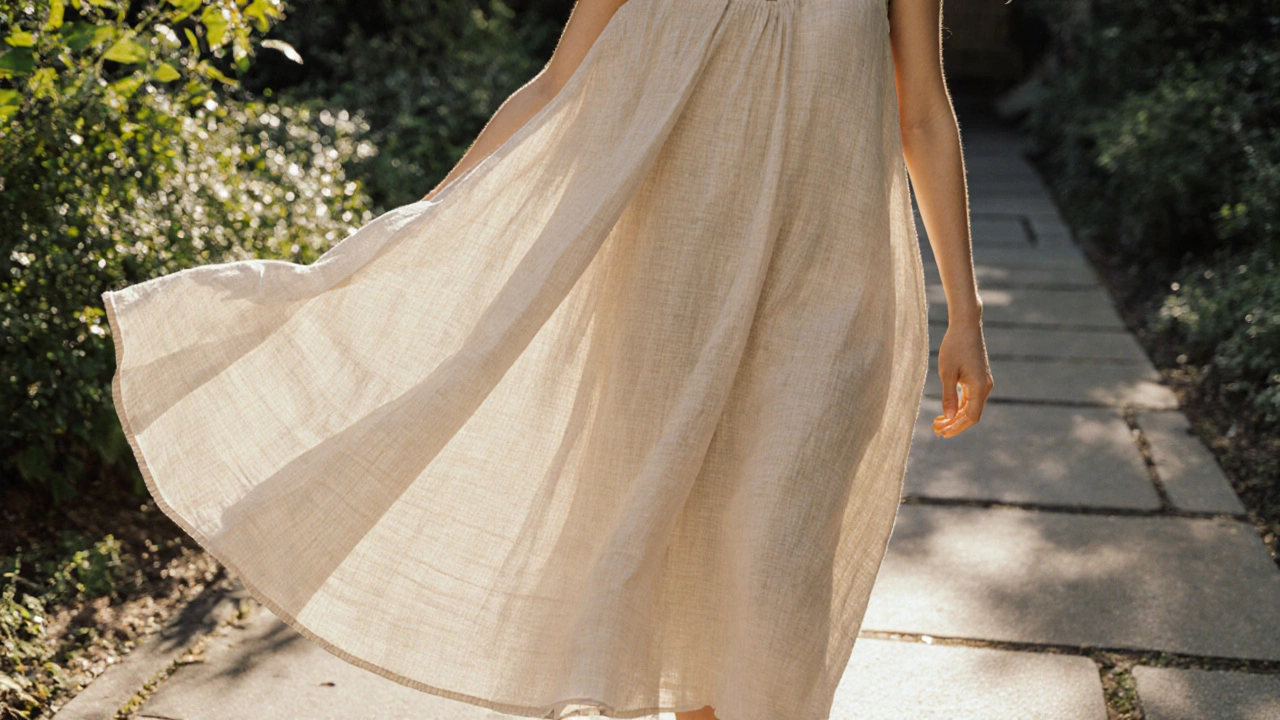When the temperature hits 30°C and the humidity sticks to your skin like a second layer, the fabric you wear isn’t just a detail-it’s your lifeline. You’ve probably worn a dress that felt like a sauna suit, or sat in a car after work only to realize your shirt had turned into a damp rag. That’s not just uncomfortable-it’s exhausting. The truth is, not all fabrics are created equal when it comes to beating the heat. Some trap sweat, some cling like plastic, and some actually help your body cool down. So what’s the coolest fabric for summer heat? It’s not just one answer, but a few that stand out for real, everyday use.
Linens Are the Original Summer Fabric
Linens made from flax have been cooling people down for thousands of years. Ancient Egyptians wore them. Mediterranean villagers still do. And for good reason: linen breathes better than almost anything else. Its fibers are hollow, which lets air move through the fabric easily. That airflow pulls sweat away from your skin and helps it evaporate faster. Unlike cotton, which soaks up moisture and holds onto it, linen dries quickly and doesn’t cling. A linen dress doesn’t just look airy-it feels airy. It’s the reason why linen shirts and dresses stay cool even in humid cities like Toronto or Atlanta. The only catch? It wrinkles. A lot. But if you’re okay with that relaxed, lived-in look, linen is the gold standard.
Cotton? Not All of It
Cotton is often called the go-to summer fabric, but that’s misleading. Regular cotton? It’s okay. But it’s not the best. Standard cotton absorbs sweat, then holds it against your skin. That’s why you feel sticky after an hour in the sun. But there’s a version that changes everything: organic cotton with a loose weave and lightweight construction. Think of it like a T-shirt from a brand like Pact or Eileen Fisher-not thick, not stiff, just soft and airy. When cotton is woven thinly and treated minimally, it lets air move and sweat escape. It’s not as fast-drying as linen, but it’s softer and easier to care for. If you want something that feels gentle on your skin and doesn’t require ironing, this version of cotton is your sweet spot.
Rayon (Viscose) Is the Secret Weapon
Rayon, also called viscose, gets a bad rap because cheap versions feel flimsy and clingy. But high-quality rayon-especially from brands like TENCEL™ or Lenzing-is a game-changer. Made from wood pulp, it’s naturally smooth, drapes beautifully, and wicks moisture better than cotton. It feels almost silky against the skin, but it’s not slippery like real silk. A TENCEL™ dress moves with you, doesn’t stick to your back, and stays cool even when the temperature climbs. It’s also more sustainable than polyester and softer than linen. The downside? It can shrink if washed in hot water. Stick to cold cycles and hang to dry. If you want a dress that looks expensive, feels luxurious, and stays cool, rayon is the quiet winner.

Silk? Yes, But Only the Right Kind
Silk has a reputation for being fancy, but it’s also one of the most naturally cooling fabrics on earth. It’s lightweight, breathable, and has a smooth surface that doesn’t trap heat. Real silk-mulberry silk, specifically-has a natural ability to regulate temperature. It keeps you cool in summer and warm in winter. That’s why it’s used in high-end sleepwear and summer scarves. But here’s the catch: not all silk is equal. Cheap silk blends with polyester ruin the effect. Look for 100% mulberry silk with a thread count under 19 momme. Anything thicker than that starts to feel heavy. A silk slip dress worn under a linen jacket is the perfect summer combo: elegant, cool, and effortless.
Why Polyester and Nylon Are Summer Killers
Don’t be fooled by marketing. Synthetic fabrics like polyester and nylon are designed for durability, not comfort. They’re made from plastic. That means they don’t breathe. Sweat gets trapped. Heat builds up. You feel clammy. Even if a polyester dress says it’s “moisture-wicking,” that usually just means it pulls sweat to the outside surface-where it sits there, sticky and obvious. In high heat, polyester feels like wearing a plastic bag. Nylon’s even worse-it holds odor and doesn’t dry well. You’ll find these in cheap fast-fashion dresses, but they’re a bad bet for anything longer than a quick errand. Save them for workouts where you’re moving hard and sweating a lot. For everyday summer wear? Avoid them.
Blends That Actually Work
Some blends are smart. Others are traps. The best summer blends combine natural fibers with just a touch of synthetic for structure. For example, a 60% linen / 40% TENCEL™ blend gives you the breathability of linen with the drape and softness of rayon. Or a 70% cotton / 30% modal mix-modal is another plant-based fiber that’s softer than cotton and more absorbent. These blends don’t wrinkle as much as pure linen, and they dry faster than pure cotton. But avoid anything over 20% polyester. Even 10% can ruin the breathability. Look for labels that list natural fibers first. If synthetic is in the top three, walk away.

What to Look for in a Summer Dress
It’s not just the fabric-it’s the cut, the weave, and the fit. A loose A-line dress made of linen will beat a tight sheath dress made of cotton every time. Open weaves, like eyelet or lace, let air flow through. Avoid anything with thick linings or inner layers. A dress with a built-in slip? Make sure the slip is also made of breathable fabric. Look for features like:
- Loose, flowing silhouettes
- Short or cap sleeves
- Open backs or side slits
- Light colors (white, beige, pastels reflect heat)
- No synthetic linings
Dark colors absorb heat. Black may look slimming, but in 32°C weather, it’s a trap. Stick to light tones. Even a pale gray or soft blue will feel noticeably cooler than navy or charcoal.
Real-World Testing: What Works in Toronto Summers
Toronto summers are humid, unpredictable, and hot. You’ll go from 28°C and sunny to a thunderstorm in 20 minutes. So your summer dress needs to handle it all. Linen holds up well-just toss it in the dryer on low for five minutes to smooth the wrinkles. TENCEL™ dresses dry overnight and come out looking crisp. Cotton blends are reliable for daily wear, especially if you’re commuting or walking. Silk is great for evenings or special outings, but you’ll need to hand-wash it. I’ve worn the same linen dress to three weddings, a farmers market, and a backyard BBQ-all in one week-and it never felt heavy or sticky. That’s the test.
Final Verdict: What’s the Coolest Fabric?
If you want one fabric to rule them all: linen. It’s breathable, durable, natural, and cools you down better than anything else. But if you want softness, drape, and easy care, go for TENCEL™ rayon. For everyday comfort with zero fuss, choose a high-quality cotton blend. Avoid synthetics unless you’re working out. And always, always pick light colors and loose fits. The right fabric doesn’t just make you feel cooler-it makes summer feel bearable.
Is cotton or linen cooler for summer?
Linen is cooler than cotton. While both are natural and breathable, linen’s hollow fibers allow more airflow and dry faster. Cotton absorbs sweat but holds onto it, making you feel sticky. Linen lets heat escape and evaporates moisture quickly, making it the better choice for hot, humid days.
What fabric keeps you coolest in humid weather?
Linen and TENCEL™ rayon are the top choices for humid weather. They don’t trap moisture-they move it away from your skin and let it evaporate. Polyester and nylon do the opposite, holding sweat and heat close to your body. In high humidity, breathable natural fibers are non-negotiable.
Is silk a good summer fabric?
Yes, but only if it’s 100% mulberry silk. It’s naturally temperature-regulating and lightweight. However, it’s delicate and requires careful washing. Avoid silk blends with polyester-they lose the cooling benefits. Silk works best for evenings or special occasions, not all-day wear in extreme heat.
Do dark colors make you hotter in summer?
Yes. Dark colors absorb sunlight and convert it to heat. A black dress can be 10-15°C hotter than a white one under direct sun. Light colors-white, beige, pastels, soft grays-reflect heat and help you stay cooler. This matters even more in humid climates where sweat doesn’t evaporate easily.
Can I wear polyester in summer if it’s labeled ‘moisture-wicking’?
Not for everyday summer wear. Moisture-wicking polyester pulls sweat to the surface but doesn’t let it evaporate quickly. It traps heat and can feel clammy. It’s designed for athletic use, where movement helps with evaporation. For sitting, walking, or being outdoors all day, stick to natural fibers. You’ll notice the difference in comfort.





